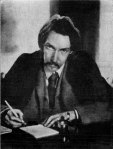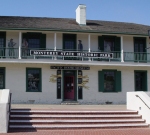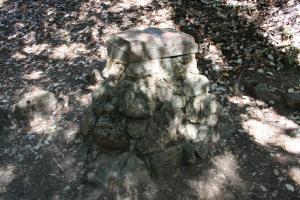Roaming in the California Footsteps of Robert Louis Stevenson
My affair with Robert Louis Stevenson started early, I was five or six. Daddy read Treasure Island aloud from a thick volume with illustrations by N. C. Wyeth while we three girls took turns sitting next to him on the couch. Little me enjoyed a kindred imagination and the vivid alternative worlds where adventure happened every day. More of that, please!
Perhaps unconsciously, I’ve followed that path, seeking outdoor thrills and ultimately creating opportunities to assuage that addiction to the adventurous options life offers. Stevenson wandered the world, so to follow his footsteps could take many months, probably years. I planned a journey in California dogging Stevenson’s tracks during 1879-80 while the young writer waited to marry Fanny Osbourne, who needed a divorce first.

After a stop in Santa Cruz to photograph the house where I lived for a while back in the day, and a brief stop at San Gregorio Beach to dip my toes in the Pacific, I nosed the rental south on 101 past artichoke fields and cattle ranches. Wind tilted the few bicyclists braving the blustery day. More than a decade had passed since I’d visited this region. Development had been contained, leaving the shore visible where the road passed close. Nature’s whiplash had gouged portions of the cliffs and flooding had eroded the roadbed, but highway department trucks and workers gave the sense that government was attentive to the problem.
Carmel-By-the Sea was my first destination. This picture-perfect secluded upscale community that nurtures the American impulse to shop was a colony for Bohemians and artists back in the 1880’s, a place where Stevenson would have fit right in. Nor did I have any trouble blending in with the Keds and khaki-clad locals frolicking with their dogs on the beach. After lunch on the shaded patio at The Village Corner, I poked around the courtyards of Carmel and discovered a charming design store selling accessories for Beatrix Potter style gardening. Carmel is still an artist’s colony. In another courtyard studio, the artist Lisa Bryan-Day showed me watercolor sketches of horses while we sipped Napa’s fruit.
At sunset I ambled through Mission Trail Park, a nature zone opposite Mission San Carlos Borromeo del Rio Carmelo, aka Carmel Mission. The meandering trails pass surprisingly close to the back gates of high-end real estate. When I focused on the woods or scanned the distance for the Mission’s red tile roof, it didn’t take much imagination to place Stevenson in the landscape leaning against a pine tree, smoking and considering the evening light. There’s no proof that Stevenson prowled these same hills, but Carmel is on the way to Point Lobos where Stevenson spent happy hours staring at the raging waves. According to his diaries, he would ride a donkey out from Monterey and stay with the goatherds camping in the Carmel Valley.

Just a few miles south of Carmel, Point Lobos juts into the Pacific. I could have biked or walked, maybe done something about that lost muscle tone, but I chose the soft bottom solution and drove through an early morning rain shower. The spectacular feast of colors that composes the Pt. Lobos landscape startled me with elaborate painterly compositions of wind bent cedars, sage green lichen on rocks along the path and purple seaweed massing in the turquoise ocean below. As I tromped along, a bunny dashed across the path. I stopped to paint two water colors trying to capture the purples, blues, yellows, greens, vermillion, and orange. One picture more or less succeeded, but the other was a pale wet mud pie. Perhaps watercolor painting is also a use or lose condition.
A baby deer stared out from a thicket that barely screened the beige backs and legs of its older relatives. I froze in my tracks to watch. Eventually, the fawn turned into the brush to hide. Intermittent sunshine formed sparkling jewels of light on the Spanish moss hanging from trees and on the knee high grass in the meadows. At sea, rocky remnants of earthquakes created a coastal barrier over which the water thunders, splashes and recedes. On Sunday morning, I headed to Monterey which lays large claims on Stevenson’s fame though he only stayed here for three months while his beloved Fanny Osborne completed divorce proceedings. A large sign on the waterfront asserts that Stevenson composed the plot to Treasure Island while walking that beach. Yet, in Napa Valley there was an historical marker that claimed he used a lookout point there as the model for Spyglass Hill.

The sailor’s flophouse where he lived in 1879 has been fixed up and renamed Stevenson House. I pressed close to the glass cases to scrutinize the writer’s silver flask, wallet, and pocket knife. The knife had all the recognizable Swiss army knife features and one curious addition we don’t need today, the button hook. My heart clutched briefly to see the man’s personal items – his lighter/flint box, a silver box that may have stored cigarettes and another for calling cards, a green velvet jacket laid out on the bed in the room Stevenson probably occupied. The quill pen and ink stand seemed too ceremonial; surely all that countryside trekking required a portable notebook and pencil.
While the well-informed state historian plied me with facts about the Stevenson family dining table that came all the way from Scotland to Samoa where Stevenson died and then back to California with Fanny and her children, I studied Stevenson’s photograph. By the lines on his face, I could tell he was a man who laughed.
Monterey was a fishing and and whaling port in Stevenson’s day. Undertaking a whale watching cruise thus seemed in character, albeit with a group of intense and rather humorless tourists clad in expensive waterproof jackets and brand new sneakers, instead of in the company of salty dog sailors. The whale watchers clustered at the bow commanding their chunk of railing until the captain asked everybody to move back. A handful of passengers huddled in the cabin, their stomachs churned by the winter wave action. While the marine biologist blared from the loudspeaker that the whales have super sensitive hearing, she praised the boat captain for staying back far enough so the whales wouldn’t hear the engines. What about the loudspeaker announcing every blow spout, I wondered, don’t the whales hear that? But then I come from the contemplative school of silent nature watching, which I imagine Stevenson shared.
Wrapping up my day in Monterey, I sped north to Napa Valley and Calistoga where Robert and Fanny Stevenson enjoyed the first weeks of their marriage. Calistoga sits among thermal geysers where Native Americans once built sweat lodges and contemporary sybarites soak in hot mineral water or mud wraps. Calistoga strives to conjure its past by cultivating a quasi-frontier era vibe with signs and store names. The railroad track that the Stevenson entourage traveled over still runs through town. Not sure what happened to the trains.
Stevenson’s ailments would have profited by the mineral baths. During his California visit he suffered from pleurisy, eczema and episodes of acute illness probably brought on by malnutrition and stress. Not one to miss a hot soak, I signed up for a mud bath which effectively ended thinking and action that day.
On the morrow, I browsed through the Silverado Museum in the St. Helena Public Library Center. Volunteers lovingly tend a collection of letters, manuscripts, memorabilia, even the lead soldiers Stevenson played with as a child and his wedding ring. During my walks around town, I searched for cornerstones in St. Helena’s older stone buildings that might fix them to 1880, but saw only handsome examples of 20th century local prosperity.
Intent on muscling up hills or down glens, I decided to hike up Mt. Saint Helena where the newly married couple occupied an abandoned mine manager’s cabin for several months in 1880 while Robert wrote The Silverado Squatters. Today, the area is part of Robert Louis Stevenson State Park. About a half-mile up the trail, far enough that some effort is required, a polished stone monument of an open book on blocks of granite memorializes the site where the miner’s cabin stood.

Another plaque I had seen in the area avvered that Mt. St. Helena was the spyglass hill in “Treasure Island‘ which was written after he, Fanny and her children went to live in the Stevenson family home in Scotland later in 1880. Right above the mining cabin site marker I climbed a rocky promontory which offered a clear view of the surrounding landscape. It was easy to imagine Stevenson settled in the chair-like embrace of the yellow orange rock, smoking and staring down at the Napa valley.
Back at the Indian Springs Resort in Calistoga, I turned to my lifelong companion of the imagination, Robert Louis Stevenson, to keep me entertained until sleep.
Details:
Carmel has no street addresses. Locations are identified by the nearest cross streets. Inns, hotels and guest houses are clustered around the shopping area. I stayed at the Tally Ho Inn (Monte Verde & 6th Streets) across the street from its more expensive and better known sister property, The Pine Inn Hotel.
Carmel: The Village Corner Bistro
Carmel area: Point Lobos State Reserve Extensive network of trails for self-guided hikes.
Calistoga: Indian Springs Resort and Spa, 1712 Lincoln Ave.
Calistoga: Calistoga Inn Restaurant and Brewery
Calistoga: Sharpsteen Museum
St. Helena: Gillwoods Cafe
St. Helena: Tra Vigne
St. Helena: Silverado Museum
Monterey: Stevenson House.
Monterey: Monterey Bay Aquarium

